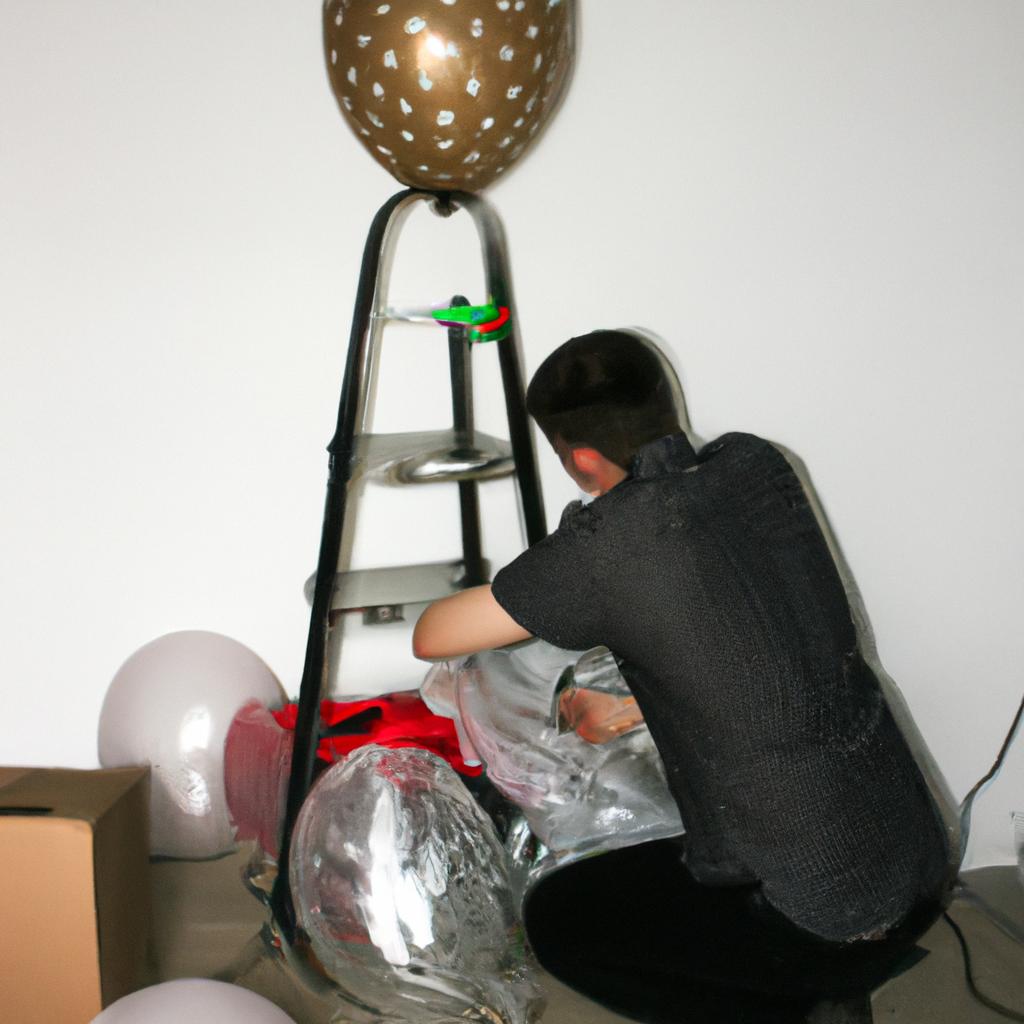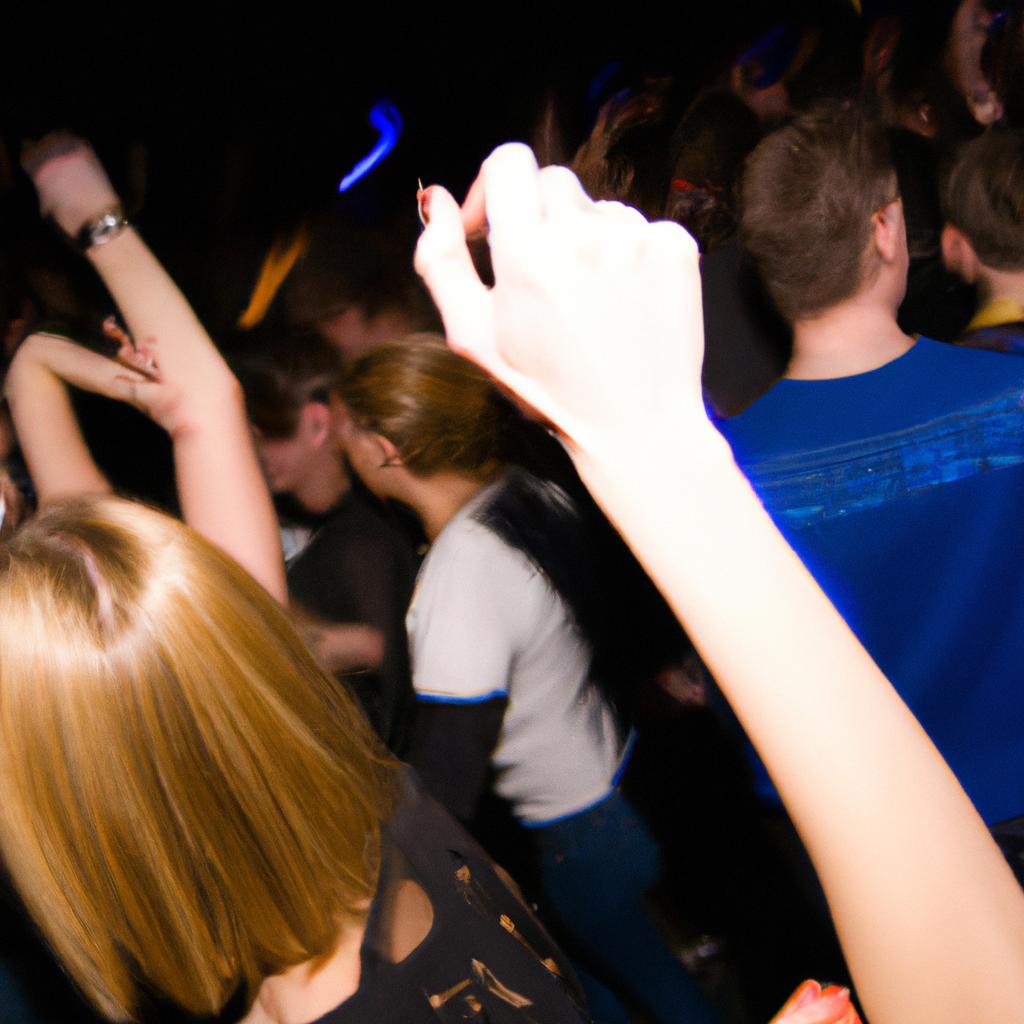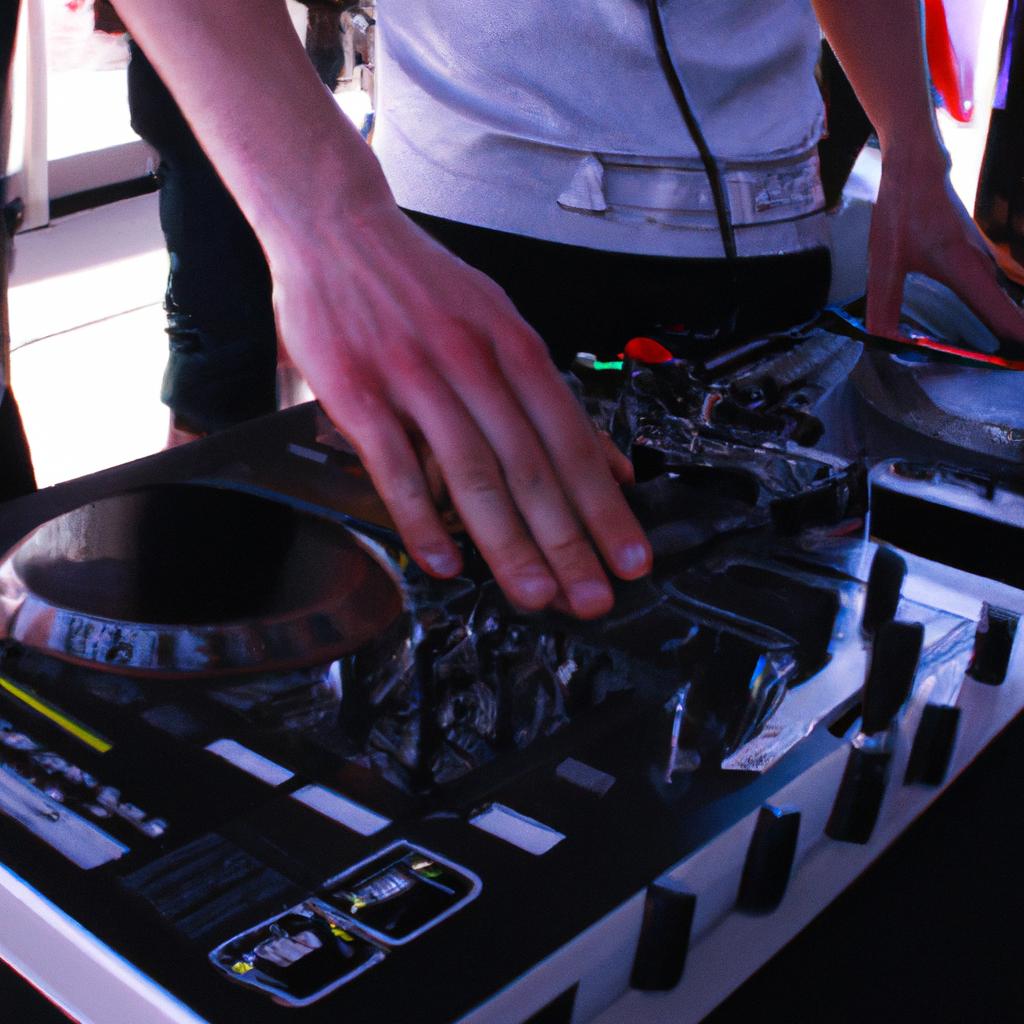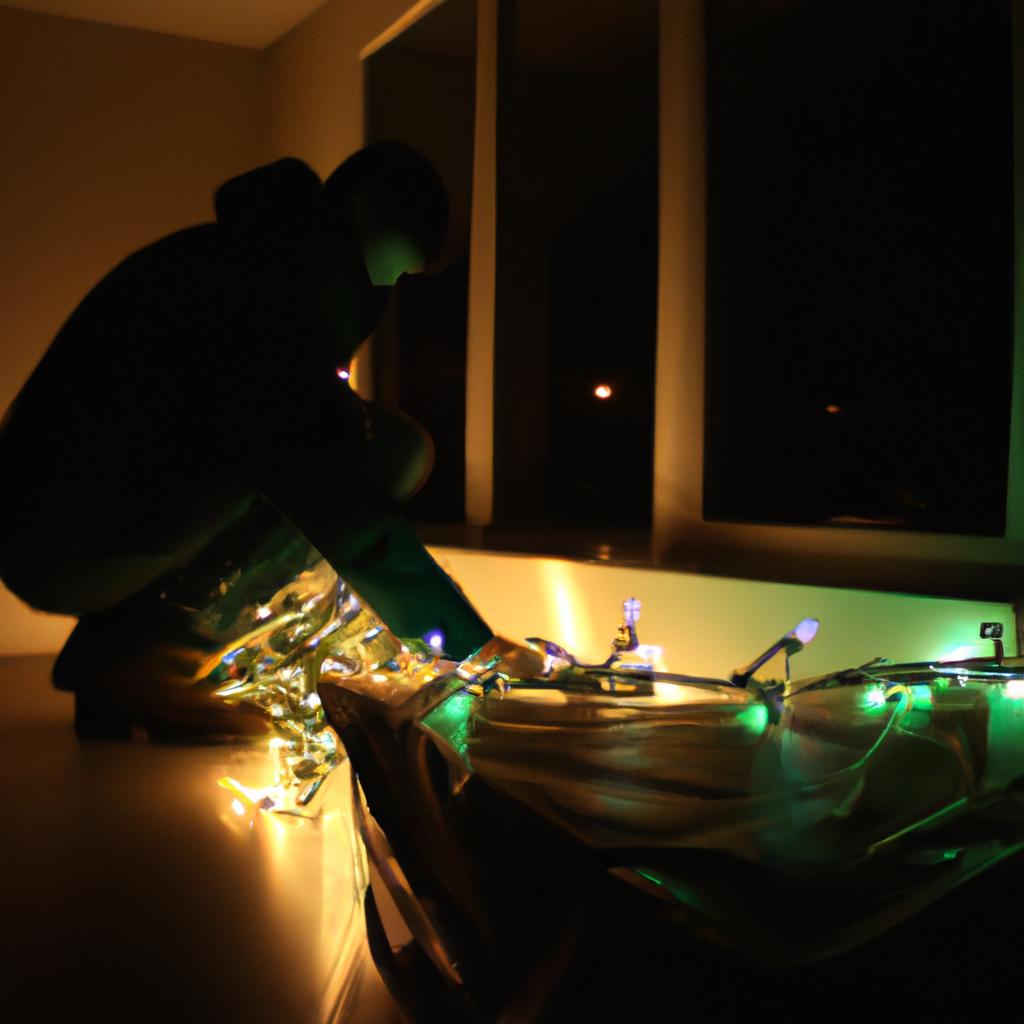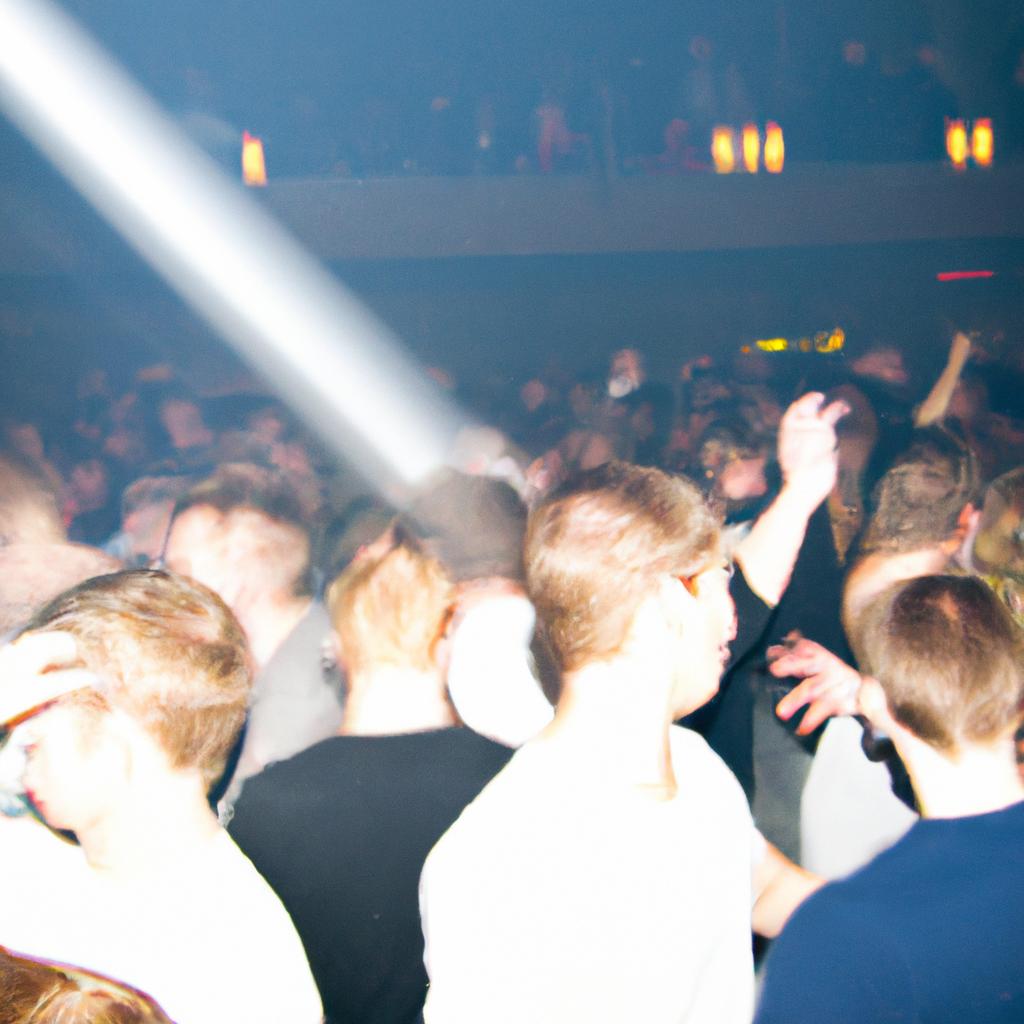Dance Floor Effects: The Atmosphere of Dance and Nightclub Parties
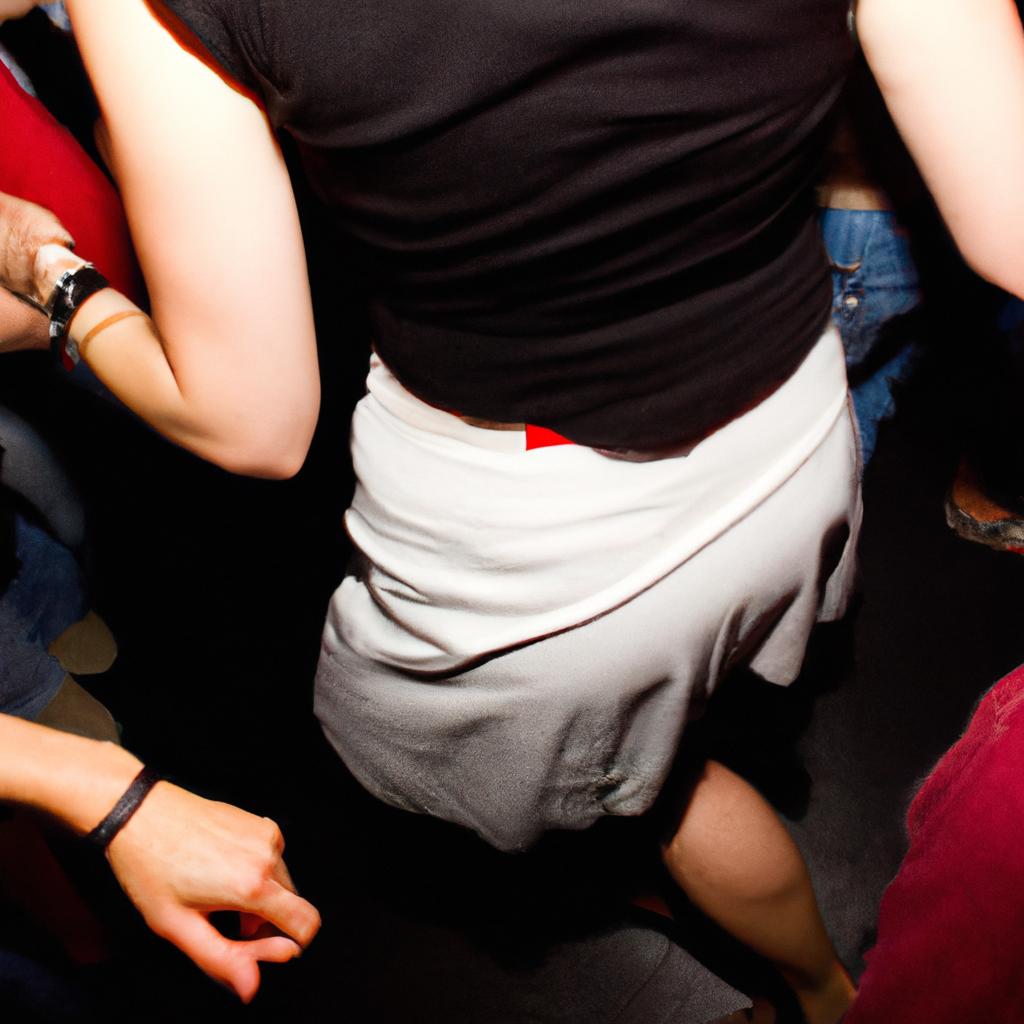
The atmosphere of dance and nightclub parties exerts a powerful influence on the individuals who participate in these social gatherings. The pulsating beats, vibrant lights, and energetic movement combine to create an immersive experience that can have profound effects on emotions, behaviors, and social interactions. For instance, imagine a scenario where a group of friends enters a dimly lit nightclub with thumping music emanating from the speakers. As they step onto the dance floor, their bodies respond instinctively to the rhythm, syncing their movements with those around them. In this article, we will explore the various elements that contribute to the unique ambiance of dance floors and how they impact partygoers.
One essential factor in creating the dynamic atmosphere of dance floors is the auditory stimulation provided by rhythmic music. The beat acts as a catalyst for physical expression by activating motor neurons and triggering synchronized movements among participants (Phillips-Silver & Keller, 2012). Moreover, studies have shown that exposure to certain types of musical rhythms can elicit specific emotional responses such as excitement or happiness (Juslin & Västfjäll, 2008). This auditory backdrop establishes a collective sense of unity among dancers as they move together in harmony. Additionally, lighting plays an integral role in Additionally, lighting plays an integral role in enhancing the atmosphere of dance and nightclub parties. The vibrant and dynamic lighting setups, which often include strobe lights, lasers, and colorful LED fixtures, create a visually stimulating environment. These lighting effects can enhance the overall mood and energy of the space, intensifying the sensory experience for partygoers. The changing colors and patterns can also add to the sense of excitement and anticipation on the dance floor.
Furthermore, the physical layout and design of the venue contribute to the atmosphere as well. Dance floors are typically open spaces with minimal barriers or obstructions that allow for free movement and interaction among attendees. This layout encourages socialization and fosters a sense of community as people gather together to enjoy themselves. Additionally, the presence of comfortable seating areas around the dance floor provides opportunities for conversation and rest between dancing sessions.
The combination of these elements creates an immersive experience that can have profound effects on individuals. The pulsating beats, vibrant lights, and energetic movement not only evoke feelings of joy and excitement but also promote a sense of belongingness and connectedness among participants. Furthermore, research has shown that engaging in rhythmic activities such as dancing can lead to increased levels of endorphins, dopamine, serotonin – neurotransmitters associated with positive emotions (Koelsch et al., 2013). These physiological responses further contribute to the pleasurable experience of dance floor atmospheres.
In conclusion, dance floors and nightclub parties exert a powerful influence on individuals due to their unique ambiance created by auditory stimulation through music, visually captivating lighting setups, as well as the physical layout design promoting social interactions. These elements combine to create an immersive experience that enhances emotions, behaviors, and social connections among partygoers.
The Role of Music in Creating a Vibrant Dance Floor
Imagine a crowded nightclub pulsating with energy as people move and groove to the rhythm of the music. The atmosphere is electric, captivating everyone present. This scenario exemplifies the power of music in creating a vibrant dance floor experience. Music serves as the driving force behind this phenomenon, influencing mood, emotions, and even physical movements.
Music has the ability to evoke powerful emotional responses within individuals. When a catchy beat or an infectious melody fills the air, it can instantly uplift spirits and create a sense of excitement among partygoers. For instance, studies have shown that specific genres like EDM (Electronic Dance Music) often induce feelings of euphoria and exhilaration in listeners due to their fast-paced rhythms and energizing basslines. The combination of these elements can trigger an adrenaline rush that propels individuals onto the dance floor.
To better understand how music affects emotions on the dance floor, consider the following bullet points:
- Rhythmic patterns: Syncopated beats or repetitive rhythms encourage body movement and dancing.
- Emotional lyrics: Songs with relatable or emotive lyrics resonate deeply with the audience, fostering connections and enhancing engagement.
- Genre preferences: Different genres cater to distinct moods; for example, upbeat pop songs may inspire carefree dancing while soulful ballads may elicit sentimental swaying.
- Tempo variations: Changes in tempo throughout a setlist can create dynamic shifts in energy levels, keeping dancers engaged and intrigued.
Moreover, music plays a vital role in facilitating social interactions during nightclub parties. It acts as a common ground that brings diverse groups together through shared experiences. A well-curated playlist can foster connectivity by eliciting collective participation on the dance floor. In fact, research suggests that synchronized movements to music promote feelings of bonding among individuals.
In summary, music holds immense significance when it comes to crafting an electrifying dance floor ambiance at nightclubs. Its ability to evoke emotions, drive physical movements, and foster social connections sets the stage for an unforgettable party experience. As we delve into the subsequent section on lighting techniques that enhance energy and mood, it becomes apparent how various elements work in tandem to create a truly immersive atmosphere.
Next, let us explore the impact of lighting techniques on enhancing the energy and mood within dance floor settings.
Lighting Techniques that Enhance the Energy and Mood
Now, let us delve further into this topic and examine how different musical elements contribute to creating a vibrant atmosphere for nightclub parties.
Imagine a scenario where a DJ is spinning tracks at a popular club. As the night progresses, they notice that certain songs consistently elicit an enthusiastic response from the crowd. One such song is “Don’t Stop Believin’” by Journey. The moment its iconic piano intro fills the room, people suddenly become more energized, lifting their arms in unison while belting out the lyrics with passion. This example demonstrates how music can ignite emotions and bring people together on the dance floor.
To better understand how specific musical elements contribute to this electrifying atmosphere, consider the following:
- Rhythm: A pulsating beat resonates within individuals, making it nearly impossible to resist tapping one’s foot or bobbing one’s head along.
- Melody: Catchy melodies have a way of sticking in our minds and evoking powerful emotional responses, leading dancers to sing along or hum even after leaving the club.
- Bassline: Deep basslines create vibrations that reverberate through bodies, intensifying physical sensations and encouraging movement.
- Lyrics: Meaningful or relatable lyrics can strike deep chords within partygoers’ hearts, amplifying their emotional connection to both the music and each other.
Let us now explore these elements further using a table format:
| Musical Element | Emotional Response |
|---|---|
| Rhythm | Energetic |
| Melody | Joyful |
| Bassline | Sensual |
| Lyrics | Empathetic |
As seen above, each element has its own unique impact on dancers’ emotions during nightclub parties. By combining these factors strategically throughout a DJ set, the atmosphere on the dance floor can be manipulated to create an unforgettable experience.
In this section, we have explored how music contributes to the vibrancy of a dance floor by examining different musical elements and their emotional effects. However, it is important to remember that these factors are not isolated; they interact with one another and contribute collectively to the overall ambiance. Now, let us shift our focus to another crucial aspect of nightclub parties: crowd interaction.
The Impact of Crowd Interaction on the Dance Floor
This section will explore how various factors such as engagement, energy, connection, and diversity impact the overall party experience.
Engagement plays a pivotal role in creating an electrifying ambiance at dance parties. When individuals actively participate by dancing, cheering, or singing along with the music, they contribute to an energetic and vibrant environment. For instance, imagine a scenario where a DJ encourages audience involvement during a popular song. As people begin to engage by clapping their hands or raising them high in unison, there is an immediate surge in excitement throughout the crowd. Such participation fosters a sense of unity among attendees and elevates both individual and collective enjoyment levels.
Energy is another influential aspect that shapes the dance floor atmosphere. A higher level of enthusiasm from participants leads to increased vitality within the space. To illustrate this concept further, consider a hypothetical situation where a live percussionist joins forces with a DJ for an impromptu jam session. As rhythmic beats blend seamlessly with electronic sounds, dancers respond with intensified movements and heightened energy. The room pulsates with infectious vigor as everyone feeds off each other’s fervor.
Connection between partygoers also has a profound effect on the overall ambiance of dance events. When individuals establish genuine connections through shared experiences on the dance floor – be it through eye contact, synchronized moves, or simply exchanging smiles – feelings of camaraderie emerge organically. These emotional bonds foster inclusivity and create an inviting environment for others to join in without hesitation.
Incorporating Visual Effects to Elevate the Party Experience:
As we explore the impact of crowd interaction on dance floor atmospheres, it is crucial to acknowledge how visual effects further elevate the overall party experience. By incorporating mesmerizing visuals such as captivating projections, vibrant LED screens, and synchronized light shows, event organizers can create a multisensory extravaganza that enhances participants’ enjoyment. The upcoming section will delve into the innovative techniques used to captivate audiences visually.
(Note: Following this transition sentence, you can proceed with writing the subsequent section about incorporating visual effects without using “step.”)
Incorporating Visual Effects to Elevate the Party Experience
The dance floor experience at parties and nightclubs is not solely dependent on music and crowd interaction. Incorporating visual effects can significantly enhance the overall atmosphere, creating a more immersive and captivating party environment. By using creative lighting techniques, mesmerizing projections, and stunning visuals, event organizers can elevate the party experience to new heights.
Imagine attending a nightclub where strategically placed LED lights illuminate the dance floor in sync with the beat of the music. As you move through the crowd, vibrant colors pulse around you, creating an electrifying energy that resonates with your every step. The marriage of light and sound amplifies each moment, intensifying the collective euphoria experienced by partygoers.
To further accentuate this effect, event organizers have begun utilizing projections as part of their visual presentations. These dynamic displays can transform ordinary walls into breathtaking canvases for artistic expression or transport attendees to otherworldly landscapes. For instance, imagine dancing beneath a starry sky projected onto the ceiling above while laser beams shoot across the room like shooting stars. This combination immerses participants in a multisensory experience that transcends traditional notions of nightlife entertainment.
Incorporating visual effects allows for endless possibilities in setting the mood and ambiance of a dance floor. Here are some examples of how these effects contribute to enhancing the overall party experience:
- Creating a sense of anticipation and excitement before entering the venue
- Establishing different thematic zones within the space
- Enhancing specific moments during performances or DJ sets
- Evoking emotions such as awe, joy, or nostalgia through carefully curated visuals
Table: Examples of Visual Effects in Nightclub Parties
| Effect | Description | Emotional Response |
|---|---|---|
| Strobe Lighting | Rapid flashes of bright light | Energy |
| Holographic Projections | Illusory three-dimensional visuals | Wonder |
| Laser Light Show | Intense beams of laser light moving in patterns | Excitement |
| LED Video Walls | Large screens displaying dynamic visual content | Immersion |
By incorporating these visual effects, event organizers can create an atmosphere that transcends the boundaries of traditional partying. The fusion of music and stunning visuals immerses attendees in a world where they can lose themselves to the rhythm while being stimulated visually.
As important as visual effects are for elevating the dance floor experience, it is equally crucial to recognize the influence DJs have on shaping the overall atmosphere. Understanding how their skills contribute to creating unforgettable nights is key to appreciating the full extent of a truly remarkable party.
The Influence of DJ Skills on the Dance Floor Atmosphere
Imagine stepping into a dimly lit nightclub, with pulsating beats filling the air. As you make your way onto the dance floor, you notice how the lighting effects enhance the overall party experience. From vibrant strobe lights to mesmerizing lasers cutting through the darkness, lighting plays a crucial role in setting the atmosphere for dance and nightclub parties.
The incorporation of visual effects not only adds an element of excitement but also creates an immersive environment that captivates partygoers. Consider a hypothetical scenario where a DJ begins playing an upbeat electronic track while synchronized LED lights start flashing in sync with the music’s rhythm. This combination instantly energizes the crowd and encourages them to let loose and express themselves freely on the dance floor.
Lighting contributes to creating different moods throughout the night, allowing DJs to curate unique experiences for their audience. Here are four ways in which lighting can influence the dance floor atmosphere:
- Dynamic color changes: By using intelligent lighting systems capable of producing an array of colors, DJs can create dynamic shifts in mood and energy levels.
- Spotlights and follow spots: These focused beams draw attention to performers or specific areas of interest on the dance floor, enhancing moments of anticipation or highlighting extraordinary moves.
- Gobo projections: Gobos are stencils placed over light sources to project patterns or logos onto walls or floors. They add visual interest and branding opportunities within a venue.
- Laser shows: Lasers provide stunning visual displays that cut through smoke or haze machines, adding depth and intensity to both small-scale club events and larger festival-style settings.
To further illustrate these points, consider this table showcasing various types of lighting effects commonly used in dance clubs:
| Type | Description |
|---|---|
| Strobe Lights | Rapid flashes of bright light that create a sense of frenzy |
| Black Lights | Emitting ultraviolet light, making white clothes and neon colors glow |
| Moving Head Lights | Automated lights that pan, tilt, and change color |
| LED Panels | Large panels capable of displaying colorful patterns and images |
As the night progresses, the lighting design evolves to match the tempo and energy levels of the music. DJs carefully select their tracks while synchronizing lighting effects to create a seamless audio-visual experience for partygoers.
Transitioning into the subsequent section about “How Venue Layout and Design Affect the Party Vibe,” it is important to note how lighting can interact with other elements within a dance club or venue. The layout and design play an integral role in maximizing visual impact, ensuring that lighting effects are strategically positioned throughout the space to enhance the overall atmosphere of the party.
How Venue Layout and Design Affect the Party Vibe
In our exploration of dance floor effects, we have already examined how music selection and tempo can shape the atmosphere of a party. Now, let’s delve into another crucial factor that significantly impacts the overall experience: the influence of DJ skills on the dance floor atmosphere.
To illustrate this point, imagine a scenario where two DJs are performing at separate parties in neighboring venues. DJ A possesses exceptional technical abilities, seamlessly mixing tracks with precision and flawlessly executing complex transitions. On the other hand, DJ B lacks finesse and struggles to maintain a smooth flow throughout their set. These varying skill levels directly affect how people respond and engage with the music.
Firstly, proficient DJs possess an innate ability to read the crowd and adapt their sets accordingly. They intuitively understand which songs will resonate with the audience and create an infectious energy that keeps everyone moving. Their seamless blending of different genres and styles creates a dynamic musical journey that captivates dancers from start to finish.
Secondly, skilled DJs have mastered the art of building anticipation and delivering climactic moments during their performances. Through strategic track selection and well-timed drops or breakdowns, they create peaks and valleys within their sets that heighten excitement on the dance floor. This expert manipulation of emotions ensures that attendees remain fully engaged throughout the night.
Thirdly, technically adept DJs possess superior beat-matching skills, allowing for smoother transitions between songs. This seamless flow eliminates any jarring interruptions or awkward pauses that may disrupt the groove on the dance floor. As a result, dancers feel more connected to both the music itself and each other as they move effortlessly in sync.
Lastly, professional DJs often incorporate creative elements into their performances such as live remixing or sampling unique sounds on-the-fly. These artistic flourishes add an element of surprise and novelty to their sets – effectively keeping dancers on their toes while also showcasing their own individual style and flair.
In summary, the influence of DJ skills on the dance floor atmosphere cannot be overstated. DJs who possess technical proficiency, a keen sense of crowd dynamics, and an ability to create climactic moments contribute significantly to the overall party experience. Their seamless mixing, strategic track selection, and creative additions elevate the energy in the venue and create an unforgettable night for all attendees. So next time you find yourself immersed in a pulsating crowd, take a moment to appreciate the skillful hands behind the decks that are shaping your dance floor journey.

